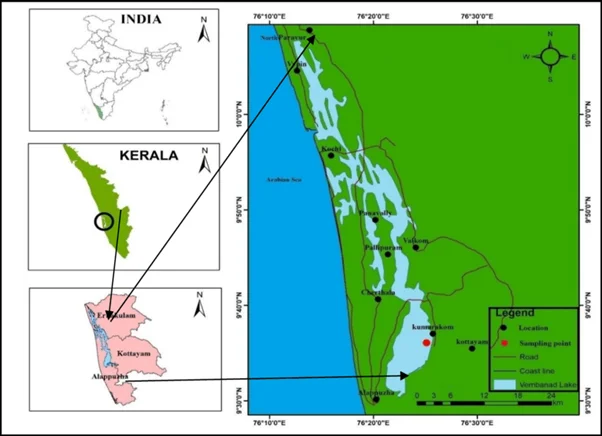Environment & Ecology
In News: Vembanad lake, is shrinking and its unique biodiversity is under threat of ecological decay despite it being declared as a Ramsar site 20 years ago.
- The lake is a source of livelihood for farmers of Kuttanad and the fisherfolk community, continues to undergo ecological degradation due to pollution and unauthorised constructions on its banks, with experts calling for “committed efforts” to save its wetland ecosystem.
Features of the Lake:
- This is the largest lake in Kerala and the longest Lake in India.
- Vembanad Lake is also known as Vembanad Kayal, Vembanad Kol, Punnamada Lake (in Kuttanad) and Kochi Lake (in Kochi).
- It is bound by Alappuzha, Kottayam and Ernakulam
- Spanning several districts of Kerala and covering a territory of more than 2033.02 km2.
- The lake has its source in four rivers, Meenachil, Achankovil, Pampa and Manimala
- It is separated from the Arabian Sea by a narrow barrier island and is a popular backwater stretch in Kerala.
- Vallam Kali (i.e Nehru Trophy Boat Race) is a Snake Boat Race held every year in the month of August in Vembanad Lake.
- In 2002, it was included in the list of wetlands of international importance, as defined by the Ramsar Convention.
- It is the second-largest Ramsar site in India only after the Sundarbans in West Bengal.
- The Government of India has identified the Vembanad wetland under the National Wetlands Conservation Programme.
- The Kumarakom Bird Sanctuary is located on the east coast of the lake.
- In 2019, Willingdon Island, a seaport located in the city of Kochi, was carved out of Vembanad Lake.

Issues:
- Environmental Degradations: the lake is facing serious environmental degradation
- Causes: recurring floods, increased pollution, reduction in water spread area and increased weed growth
- Bunds on the lake were crumbling at certain places, making fishing difficult and on top of that the lake requires regular dredging and desilting.
- Tourism poses a threat to the ecology nd the water quality of the lake. Resorts and residences discharge their waste into the river and many houseboats do not have bio-toilets
Solutions
- Inter-departmental committee to carry out a comprehensive study on checking the existing backwaters and to take further steps
- Local self-government departments taking action to detect and clear encroachments and demarcate the lake’s boundaries
- Participation of local communities including fisherfolk and farmers in lake’s revival
- Building an outer bund to prevent silt deposition and to regulate saline water intrusion into the freshwater lake
- Swaminathan Foundation report of 2011 – scientific and efficient operation of the lake
- Waste disposal and sewage treatment along the lake to be closely monitored.
Miscellaneous:
- Kuttanad is known as the rice bowl of Kerela
Must Read: India adds 11 more wetlands to the list of Ramsar Sites
Source: The Hindu














